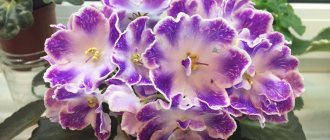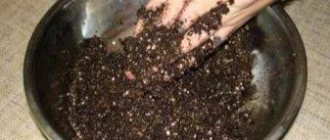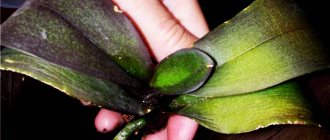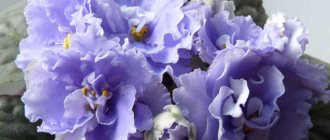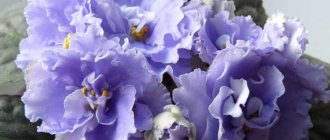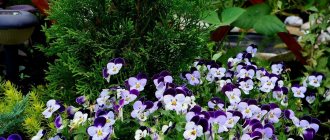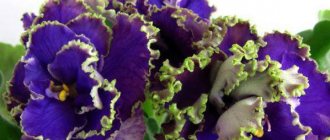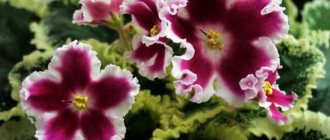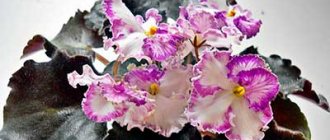Violets presented at exhibitions :
- Always attracts the eye;
- And they amaze with their abundant cap blooms.
But it is not always possible to achieve such abundant flowering at home.
The secret of lush flowering is simple, just enough :
- Follow the rules of agricultural technology when growing Saintpaulias;
- And know what conditions are needed for a certain variety of violet.
What does Esmeralda violet look like?
Violet LE Esmeralda is a delicate, touching flower that does not stand out with particular brightness or splendor. But at the same time, the flowering is abundant, due to which this whole amazing picture is created.
Violet LE Esmeralda
Plant characteristics
Botanical description of Saintpaulia Esmeralda:
- the flower is large, bright crimson in color, with fringe along the edges;
- along the edge of each petal there is a light green edging, which brightens over time;
- leaves of a standard oval shape, slightly tapering towards the end, become wavy over time;
- The color of the edging can be maintained if the room temperature is maintained at a consistently cool temperature.
Interesting! The main feature of this plant is that even the first flowering is very abundant.
Violet Esmeralda belongs to the Gesnerieceae family, genus Saintpaulia Hybrida.
Briefly about the history of appearance
The violet got its name in honor of the famous gypsy from V. Hugo’s novel “Notre Dame de Paris.” The color of its petals and the lace around the edges reminded the breeders working with the variety of this beautiful girl. The variety has several varieties.
The difference between the varieties Esmeralda and Esmerald Lux
LE Esmeralda Lux is one of the varieties of the hybrid. It was bred by breeder Elena Lebetskaya, who became the author of most varieties. This hybrid is characterized by greater terry and petal size. The color saturation is also slightly different. In this case, they are either raspberry-burgundy or fuchsia. The light green border along the edge of the flower remains unchanged throughout the entire flowering period.
Violet Esmeralda Lux
Sports of this type
A sport of violets is considered to be any minor but regularly recurring difference in a number of plants belonging to a given species. These differences may be expressed in the shape of flowers or leaves. Sport Esmeralda is a completely similar plant, the leaves of which are as curly as the flowers. But the color of the delicate petals itself is completely pink.
Esmeralda - sport of violets
Violet Stassia: variety description and characteristics
Violet Stassia: photo
Many experienced flower growers are familiar with the name of Konstantin Morev, who became the author of the most incredible and beloved Saintpaulias - indoor violets. This breeder has been working on breeding violets, crossing and obtaining new attractive varieties for more than 25 years, and his track record includes more than a hundred varieties and varieties of violets that can satisfy the tastes and needs of even the most demanding gardeners. These violets are not inferior in their beauty and attractiveness to varieties of foreign violets and have long become a real calling card of domestic indoor floriculture. Many experienced flower growers know the varieties that were bred by Morev. In particular, they fell in love with such an interesting and wonderful specimen, which is called violet SM Stassia. This violet was bred by a breeder, but Morev himself calls it more of a seedling than a full-fledged bush for its miniature size, and at the same time quite abundant and bright flowering. The flowers at the planting grow semi-double, lush, their shape is incredibly aesthetically attractive, and the transitions in the shade format are the most diverse. Stassia violet petals can be painted in a bright red hue, in smoky burgundy colors, there can be white colors, and you can also notice a slight pinkish blush on the petals, which seems to demonstrate the embarrassment of this variety for its own beauty and aesthetics.
Violet Stassia Moreva has one distinctive feature, namely, on the wavy border you can see a greenish or white color, which seems to highlight the flower, making it flirty, and at the same time quite bold. This makes the edges of the petals look even more solemn and festive, and in general violets of the SM Stassia variety stand out against the background of many other indoor flower plantings. One plant can have completely different colors, and this gives the feeling that it is not one, but several different varieties at once. The coloring has a gentle gradient transition that amazes the imagination and can satisfy the needs of absolutely anyone, even the most capricious gardener, who strives to obtain decorative and attractive accents on their own window sills or rooms. The color has transitions from pale tones to very bright ones, the strokes also look quite attractive and interesting in contrast, and this looks very interesting and funny in the overall picture.
From the cuttings of the violet Stassia Moreva you can get a lot of planting materials - children, neat and compact rosettes are also formed, flower stalks appear that bloom wonderfully. By the way, I would like to separately emphasize that this variety has a long flowering period, and the gardener will have much more time to enjoy the wonderful external characteristics of this planting. For a long time, the flowers retain a very fresh appearance; they do not crumble, curl or wrinkle for a very long time. Therefore, when fresh buds are just blooming, the florist can be pleasantly surprised by all the abundance of flowering and colors, and the violet variety SM Stassia Moreva can really be very pleasantly surprised with just such qualities. The flower itself is very attractive, some even call it whimsical, as it produces a variety of shades and colors. Even if the mother flowers are colored in the same range, one must somehow expect that the color of the resulting flowers will be much more interesting and attractive. For example, if a plant previously bloomed in a burgundy shade, then its cuttings can bloom in completely different shades, and it is not necessary that burgundy will remain among these shades.
Of course, the external characteristics of the plant depend entirely on how the grower himself cares for the plantings. It is very important that the grower follows all agrotechnical rules and cares for the plant, taking into account its properties and characteristics. Only in this case will the Stassia violet be healthy, strong and very decorative. To do this, you need to take into account some rules and nuances so that future landings feel as comfortable as possible. As a rule, only in comfortable conditions will violets be able to open up completely, and will also be able to fully demonstrate their characteristics, very important bright characteristics and properties. So we will devote the next part of this article to how to properly care for violets of the Stassia variety, how to propagate them indoors, while preserving the attractive properties and characteristics of the mother shrubs.
Features of caring for violet LE Esmeralda at home
Like any Saintpaulia, LE Esmeralda is a rather finicky plant, but any gardener can cope with its cultivation, especially an experienced one, one who has been breeding violets for a long time.
Temperature and lighting
Violet Ice Rose - description and characteristics of the variety
The optimal growing temperature is +18..+24 °C. The cooler the room, the lighter the petals.
Proper lighting is one of the components of success in growing violets. Daylight hours should always last long, not only in summer, but also in winter. Therefore, at this time of year, it is necessary to artificially increase the duration of daylight hours using fluorescent or phyto lamps. In total, violets should be illuminated for at least 15 hours a day.
Important! In summer, pots should not be placed on window sills, especially on the south side. In hot sunny weather, it is better to move them further away, since the delicate leaves of Esmeralda can be seriously damaged by sunburn.
Watering, spraying and humidity
Wick watering or watering through a tray is preferable. The water should be warm, soft, well settled.
Violets should not be sprayed, as droplets of moisture cause yellow spots to form on the leaves. The leaves and flowers of the plant, in principle, prefer only bottom watering (through a tray or wick), but you can carefully water the flowers up to the root.
Violets do not like it when the room is dry. Therefore, the air must be humidified. This can be done using containers filled with water, wet expanded clay, and wet moss. For those who have entire collections of Saintpaulias and other moisture-loving plants, it is recommended to purchase an air humidifier.
Wick watering of violets
Priming
The main properties of soil for violets: nutritional value and friability. It is best to purchase special soil for Saintpaulias in the store. But you need to carefully look at its composition. If there is no perlite in it initially, then it is worth adding it or coarse river sand.
Feeding
During the first 6 months after transplantation, no feeding is required. They are then applied according to life stage.
- At the very beginning of the growing season, nitrogenous fertilizers are applied, which stimulate the active growth of the green part.
- During the flowering period, potassium-phosphorus fertilizers are applied, which promote more luxuriant flowering.
Fertilizing is done in conjunction with watering. If watering is wick, fertilizers are applied directly to the water.
Contents in room culture
, classic care regimens are sufficient :
- Ideally, the seedling will be placed on windowsills facing western or eastern directions; when placing it on a north window, it will definitely require lighting with natural spectrum lamps, and on a south window – slight shading in the heat;
- You can water in small doses , after preliminary light drying of the upper tier of the substrate;
- Fertilizing should be done according to visually indicated need;
- Lighting must be created in a natural, long-lasting and diffuse spectrum;
- Temperature should be maintained within +20 + 24°C without sudden fluctuations;
For good growth, the flower needs proper care. - Humidity can be increased in any way, excluding direct spraying of violets;
- The soil used is nutritious, well aerated, permeable, with mandatory drainage;
- transplantation using gentle transshipment, except in unforeseen cases.
When and how does it bloom
Violet Fairy - description and characteristics of the variety
The plant blooms throughout almost the entire year. The flowers are cute and original. They can be plain or terry, depending on the particular variety of Esmeralda, with fringed edges.
The flower shape of this species is Pansy.
The plant blooms almost all year round, with the exception of a short dormant period of 1-2 months.
No special changes in care are required during flowering. It is important to remove dried buds in a timely manner. Fertilizing with complex fertilizers is carried out 2 times a month.
Comments (10)
Marinka
05/05/2018 at 00:32 |
Violets in general, in my opinion, are very capricious plants, although they are beautiful, but we have them at home, we water them not from above, but as it should be from below, nevertheless there are some difficulties with them.Answer
Yulia Expert Plodogorod
07/09/2019 at 23:10 |
Hello, Marinka! Yes, there are difficulties when growing violets. But it’s not difficult to deal with it or prevent them from appearing at all. You just need to know some features of care.
These flowers require long daylight hours. Therefore, in order to admire the buds in winter, you need to use additional lighting sources for indoor flowers. But it is best to avoid direct sunlight, especially in spring and summer. The easiest way is to install a protective screen on the glass. Thin paper or parchment is suitable for this.
These plants require regular application of complex mineral supplements. We also recommend removing excess stepsons. This depletes the strength of the bush, makes it weak, and the buds small and inconspicuous.
We do not recommend using plastic pots to grow these flowers. Also, violets do not feel well and begin to rot in containers that are too large. The diameter of the pot should be approximately 30-35% of the crown volume.
Do not water violets with cold water. This can provoke both developmental inhibition and some kind of disease. Also, a plant that is in too dense and heavy soil will not feel good. When planting violets, you need to add various cultivators, such as peat, to the soil.
As for watering, it is quite rightly noted that it is better to do it through a tray. We would like to note that the plant suffers from both excess moisture and too dry soil. Therefore, you need to establish a regime of respect yourself, based on the condition of the plant, the size of the pot, and the temperature in the room.
If your plants often die, we recommend checking other house flowers for pests. This could be a spider mite, aphids, scale insects, or some other rarer uninvited guests.
If, despite full compliance with all the rules for planting and growing, the flower still develops poorly and has a lethargic appearance, you need to conduct a careful inspection and determine the type of harmful insects and treat the bush with an appropriate preparation.
Answer
Natasha
05/08/2018 at 00:27 |
They are beautiful violets, but they really need special attention; we protect ours from direct sunlight and replant it in special soil with nutrients so that it grows better.
Answer
Yulia Expert Plodogorod
07/09/2019 at 23:34 |
Hello, Natasha! This home flower is quite picky about the structure and composition of the soil. If the soil is prepared incorrectly, the violet may develop poorly or even get sick and die.
If you prepare the soil mixture yourself, we recommend using the following composition: leaf soil - 60% of the total amount of required soil and peat and sand in equal quantities.
Instead of leaf soil, you can also use turf soil. Sometimes soil from under coniferous plants is used. For looseness, you can also add sphagnum moss or charcoal. It is important to take into account such a requirement as acidity. The soil should be slightly acidic or neutral.
We would like to note that regardless of whether purchased or self-prepared soil is used for planting, it must be disinfected. After all, there may be harmful insects or some kind of infection in the ground.
In order to disinfect the soil, you can water it with a solution of manganese, boric acid, the drug Fitosporin, or just boiling water. To check whether the soil mixture is the right consistency, lightly wet the soil and squeeze a handful in your palm. If the shape practically does not hold and the soil crumbles almost immediately, everything has been done correctly.
The fact is that even if you strictly adhere to the recommended proportions, you may not get the desired result, because the components are very different. Even soil collected from two adjacent plots may have different qualities, not to mention general recommendations for preparing the substrate.
Answer
Valeria
05/13/2018 at 00:07 |
I have several types of violets growing at home because I love them so much. I don’t know about others, but I’ve never had a problem with them, the main thing is proper watering and caring for these plants.
Answer
Yulia Expert Plodogorod
03/11/2020 at 01:28 |
Hello, Valeria! You are absolutely right, well-established care and especially proper watering are the key to successful violet growing. In addition, it is important to replant the bushes in a timely manner. As a rule, the procedure is necessary once a year. During the transplantation process, you can replace the substrate with a fresh and nutritious one.
At the same time, it is not always necessary to replace the flower container. After all, using a pot that is too large can result in a lack of buds and root diseases. If the leaves of the flower have become smaller and the flowering is sparse, it is necessary not only to replace the substrate, but also to select a larger pot.
It is better that the new pot is 1.5-2 cm larger in diameter than the previous one. It is better to plan replanting work at the beginning of spring. The most commonly used method is transfer, and fresh soil is added to fill the voids of a larger container. But, this option is possible if the roots of the flower are completely healthy.
If sanitation is required, the old soil is severely depleted or infected, it can be washed off with a gentle pressure of slightly warm water. This procedure is quite traumatic for the flower, so it is used as a last resort. It is worth laying drainage at the bottom of the vessel, and when all the work is completed, water it.
Answer
Lena
05/25/2018 at 00:21 |
My little daughter always forgets how to water violets correctly, I had to give up this type of plant, so as not to upset her with comments every time, I took everything to my grandmother.
Answer
Yulia Expert Plodogorod
03/11/2020 at 01:56 |
Hello, Lena! Given the circumstances, we recommend trying watering the described flowers using a wick. You need to start by preparing two containers. This is a plastic pot directly for the violet and a vessel with water on which the flower can be placed.
The second container can be a plastic cup, a cut from a bottle, or something more decorative, such as an outer pot, which is usually used for orchids. You also need the wick itself. A nylon cord 15-20 cm long is suitable for this.
The violet that will be grown on the wick must be removed from the old container and remove as much soil as possible from the roots without damaging them. You need to thread a wick through the drainage hole of the new pot, fill it with soil and water it thoroughly. Afterwards, you need to make a hole in which to carefully place the roots of the transplanted violet.
After this, you can water the plant again under the edge of the pot using a watering can with a thin spout. Excess moisture should be drained from the pan, and then place the plant in a second container, which is already filled with water. In this case, the lower end of the wick should be immersed in moisture.
When using this method, you need to make sure that the water does not run out and does not begin to emit an unpleasant odor. At first, we recommend observing the condition of the flower to understand how successful the transplant was and whether this method of moisturizing is suitable for your plant.
Answer
Galina
07/02/2018 at 00:48 |
Violet is not a whimsical plant. Its roots are delicate, so you should not overwater or dry out the soil too much, shade it from the bright sun and it will delight you with abundant flowering.
Answer
Yulia Expert Plodogorod
03/11/2020 at 02:15 |
Hello, Galina! We would like to note that for normal development it is also important to carry out hygienic measures for violets. In their natural habitat, violet bushes are washed by rain, and the moisture is dried by a warm wind. You can replace these procedures at home with a shower and spraying. This should be done if the sheet plates are covered with dust and dirt.
Although such bathing cannot be done too often, you should not neglect cleansing the crown either. Dust will interfere with the plant's normal respiration and may even interfere with photosynthesis. It is better to place a wet violet after a shower in a shaded, warm place without drafts.
You can return the flower to its usual windowsill when all the moisture on it has dried, in order to protect the sensitive crown from sunburn. After this procedure, you need to wait a while with watering, since the plant is already well saturated with moisture.
To maintain the health of Saintpaulia, you need to regularly prune the bush. It should not have more than 3 tiers of leaves. We recommend removing the foliage located below without leaving stumps. Sluggish, weak, pale leaf blades and faded buds should also be removed.
Answer
How Saintpaulia LE Esmeralda propagates
Propagation of the large-flowered Saintpaulia LE Esmeralda occurs only by cuttings or peduncles. The most popular method is cuttings.
Violet Magenta - description and characteristics of the variety
To do this, select the strongest sheet from the second row. It is placed in a glass with warm boiled water. As soon as the root system grows to about 1 cm, the shoot can be planted in the prepared soil.
It is possible to plant the leaf in the substrate immediately. It needs to be buried approximately 1/3 of the entire length and covered with polyethylene or a glass jar.
Attention! Every day the shelter must be raised for ventilation, and the level of soil moisture must be monitored so that it does not dry out.
Violet cuttings
Violet Curly Sue (K. Morev)
Author of the variety
The seedling “Curly Sue” belongs to the collection developments of the famous Moscow breeder Konstantin Lvovich Morev , who has been working on the formation of new types of violets since 1994. Being a student of the master of domestic selection B. M. Makuni, Konstantin Lvovich takes a very responsible and professional approach to the process of creating and registering new varieties of Saintpaulia.
The violet variety Curly Sue was developed by Konstantin Lvovich Morev.
At a certain stage of growing the next varietal plant, the master obtained a seedling “Curly Sue” , which was distinguished by:
- Original coloring;
- Lush formation of buds;
- And a rather unpretentious character.
But the specimen, in its individual characteristics, did not meet the high standards that distinguish all varieties of K. Morev. Therefore, the seedling was rejected by the author, but because of its attractiveness it “went” to flower growers, where it received a name, as well as being in demand. The author still does not intend to transfer the seedling to the category of varieties.
Taxonomy of the variety
"SM-Curly Sue" in the taxonomic classification is a representative of the genus Saintpaulia , part of the Gesneriev family. The violet did not receive varietal characteristics from the author, is not registered as an independent varietal plant, it is listed in all catalogs as a Morev seedling.
Curly Sue is a member of the Saintpaulia genus.
According to the diameter of the leaf rosette, the violet belongs to the standard type , according to the fullness of the corolla it is classified in accordance with the terry appearance, and according to the color of the bud it is characterized as finger-colored.
Description of appearance
The violet forms a leaf rosette along the average numerical boundary of the standard type. The bush is always different:
- Aligned configuration;
- Sufficiently dense filling;
- And a beautiful arrangement of sheet plates using mosaic technique.
The leaves of the seedling have :
Violet Curly Sue blooms in the form of a bouquet.
- Rounded outline;
- Smooth surface structure;
- Coloring with a color scheme of lush summer greens with a slightly lighter veining pattern;
- Finely notched serration of the edge;
- And slightly elongated leaf petioles.
Flowering in the seedling occurs in a bouquet type with the formation of a significant number of buds that open into very large corollas of terry fullness. Flowers receive additional volume due to:
- Waviness of the lateral edges of the petals;
- And the fringed ruggedness of the contour.
The coloring of the corollas is characterized by the presence of symmetrically located ruddy prints on a main peach-white background - one gets the impression of a soft pink bouquet with brighter accents of varying intensity in the pink and scarlet range.
The fringe of the petals is always surrounded by a white border, although at high temperatures the width of the white shade is significantly reduced. The seedling retains its color consistently from flowering to flowering.
“Curly Sue” prefers to bloom almost without interruption , leaving little time for rest.
Attention! No sports were identified in the seedling.
Transplantation after purchase and during reproduction
After purchasing a violet, you should not replant it immediately. It must go through the incubation period in the same container in which it grew in the store. For 14 days, the plant should be protected from the rest; it is advisable to place it in a separate room. This is necessary in order to protect home flowers from diseases and parasites that Saintpaulia can bring with it.
Further transplantation is carried out by transshipment. Transplantation to a new place is carried out once every 2 years, more often, but not less often. The size of the pot should increase slightly each time, but it should not be too deep.
In a large pot, the growth of the plant will slow down, since it will be absorbed primarily by building up the root system. Only after it has entwined the earthen lump will the ground part begin to develop.
Features of reproduction
The chimera violet reproduces in a special way. Breeders are unable to develop this variety in the laboratory. This type of Saintpaulia appeared as a result of a partial mutation. The overwhelming majority of cells received maternal characteristics, a smaller part received characteristics of another species. This mutation occurred more than 100 years ago, when violet was cultivated and gained popularity among flower growers.
Initially, such mutations were random. Different types of fabrics were adjacent to each other without mixing. That is why she was unstable and did not reproduce during the breeding process. For example, a pink Saintpaulia with a lilac stripe gave a uniform color when propagated.
The official community of flower growers did not immediately agree that chimeras are a separate variety. Representatives explained the refusal by the fact that when propagating by cuttings it is impossible to achieve the same color. However, the instability of reproduction has been eliminated and at the moment there are no particular difficulties with the registration of new varieties. Flower breeding methods are quite labor-intensive, which affects the cost of planting material.
Reproduction methods:
- violation of the plant growth point;
- rooting of the peduncle;
- rooting the upper part of the violet.
These methods allow you to preserve the characteristics of the chimeric violet. Propagation by cuttings is not suitable for these varieties of Saintpaulia.
Possible problems in growing
Most problems occur due to improper care, but there are also diseases to which Saintpaulias are predisposed. Occasionally, violets are attacked by insect pests.
Problems with leaves
Problems with leaves are most often associated with improper care. Thus, yellowing and the appearance of spots on the leaves are most often associated with hypothermia. Watering with cold water or excess moisture can provoke the development of root or stem rot, causing the leaves to droop and turn black.
Lack of light will cause the cuttings to stretch and elongate. And excess lighting and heat can cause wilting, drying out and sunburn on the leaf part.
Pests
The main parasitic insects that can harm Saintpaulia LE Esmeralda:
- Ticks that cannot be seen with the naked eye. They settle on aging leaves. Traces of their vital activity appear in the form of white dots on the leaves. Leaves affected by mites are cut off.
- Thrips. They can also only be seen under a microscope, but unlike ticks, they can fly. Houseplants most often get pollen or poplar fluff from the street.
- Aphids can kill violets. The external manifestation of its vital activity is the withering of the leaves, which then turn yellow and fall off.
To combat any insect pests, special preparations are used - insecticides, which can be bought at any flower shop.
Diseases
The most common diseases are:
- Powdery mildew (real or downy) is characterized by the appearance of a powdery white coating on leaves and stems. The false variety is also accompanied by brown spots on the leaf blades.
- Rust affects the leaves, which become covered with rusty spots, then the rest of the flower suffers.
- Root and stem rot are the most dangerous diseases that occur in Saintpaulias as a result of hypothermia and/or overwatering. The appearance of this disease is detrimental to plants. If found, the flower can be thrown away, since it cannot be saved, but the pot can be thoroughly disinfected.
Powdery mildew on violet
Signs of improper care
- with a lack of light, new leaves will be lighter and smaller, the petioles will be stretched, the edges of the leaves will bend upward;
- increased acidity or excessive salinity of the soil leads to curling of leaf plates, the same problem occurs with a lack of nitrogen or overwatering;
- light spots on the leaves or their tips hint to the grower that the flower is watered with too cold water or is suffering from sunburn.
It is better for beginners not to start growing this plant; it is worth practicing on more unpretentious flowers.
Saintpaulia Esmeralda fully lives up to its name with its bright double flowers, of which there are many, starting from the first flowering. This variety will definitely decorate any collection. However, it is better for beginners not to start growing this variety, since it is not so easy to cope with.
Summary
Violet Stassia: video
Violet Stassia is a violet bush that is loved by many gardeners; this flower is very unpredictable, and hardly anyone can reveal the secret of its flowering. It is impossible to predict what shade the Stassia will bloom in, it will not be possible to determine in advance how abundant and unexpected this flowering will be, and of course this greatly attracts flower growers to such uncertainty. Flowers can be very different not only in the nature of their color, but also in their shape, since they can be very double, semi-double, they can be very large, and there are also dwarf specimens. Perhaps even the breeder himself did not expect that such a planting would result, and that is why today the Stassia violet is so in demand and interesting within the framework of indoor floriculture.
In general, violets are very attractive plantings, so it is imperative to monitor them and their general condition, because this is the only way to preserve not only the external characteristics of the violet bush, but also the beauty of its flowers. By the way, flowering can be extended precisely due to competent agricultural technology, providing the Stassia Moreva violet with care and all possible conditions so that it is content and feels full. The temperature should not drop too much, air humidity should be within normal limits, and it is also necessary to regularly monitor the Stassia violet variety. To do this, it is examined for diseases or emerging bacteria and pests. It is worthwhile to prevent diseases and pest attacks, and take care to increase the plant’s immunity. This is the only way to achieve reciprocity from the Stassia violet in the form of beautiful flowering.
General description of the plant, flowers, appearance
The variety was bred through selective breeding. In 2010 it was presented at a flower exhibition. Photos of Eve's violet present a very pretty picture, since thanks to the huge number of pedicels the plant looks like a blooming ball. Flowering lasts about 2 months.
All the buds bloom at the same time, so the ugly rosette is masked by lush violet petals. Due to the fact that the plant produces a huge number of pedicels, their fragility is compensated by supporting each other.
Violet Eve prefers the sun, so the color of the buds, leaves, number of peduncles and quality of flowers will depend on the location of the flowerpot. It is believed that the variety blooms early and pleases the eye with delicate inflorescences for a long time.
Distinctive features of Eve in comparison with other varieties
Violet Eve differs slightly from its relatives, but the species still has unique features. It is worth paying attention to the following nuances:
- Non-standard coloring, which depends on how much light the plant receives.
- A weak and unsightly rosette often does not support flowers, so several flower stalks can intertwine with each other.
- Long flowering, which can last about 2 months.
- Ease of care and breeding, as well as love for direct sunlight, significantly distinguish the presented variety from the rest.
Otherwise, Eva is completely similar in terms of care to other violets.
Source
Reviews
Olya. “The variety is really good! Even in the first flowering it blooms with a cap. Only my girls were attacked by thrips. I had to cut off the flower stalks... Moreover, I read on the Internet the advice to sprinkle with celandine tincture. It burned the leaves... Now it won’t bloom soon.”
The variety in question has captivated many gardeners with its appearance.
Ivan. “Always in bloom. The hat always lasts a long time. And he also likes to pretend to be a chimera.”
